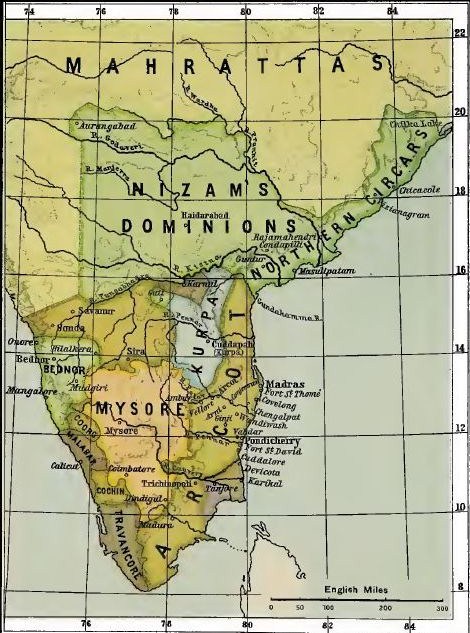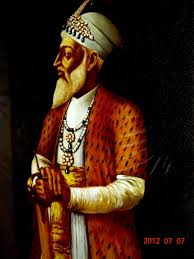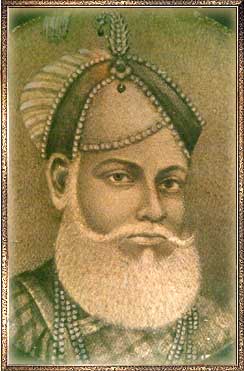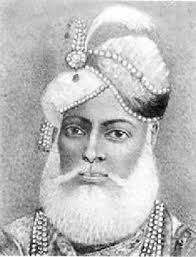The battle of Plassey in 1757 is generally- albeit wrongly- regarded as a watershed moment which heralded the beginning of British hegemony in India. The events at Plassey might have never come to pass but for the machinations in the southern end of the country a few years before that historic battle.
We shall now recount the events in the south that set the stage for British hegemony in India. Due to sheer length I have divided this article into two parts. In today’s article we shall see the circumstances under which British intervention in Indian affairs started and in part two we shall recount the final triumph of British arms which set the stage for the foundation of the British Raj. For convenience I have used the present day names for all places (with the exception of Madras/ Chennai).
Southern India in the 1740s
As we saw in the previous article, the Persian invasion in 1739 left the Mughal emperor in Delhi a mere figurehead, strengthening regional Satraps who consequently became absolute rulers even though they nominally owed suzerainty to the Sultan in Delhi. One among them was Mir Qamaruddin Khan, who had been nominated Nizam-ul-Mulk by the sovereign in Delhi, leaving him in charge of the region known as the deccan (a corruption of दक्षिण- dakshin, the Hindi word for south). With his capital in Hyderabad, the Nizam presided over a vast territory which included several parts of present day Maharashtra and most of southern India.

Map of the Carnatic Region
The dominions of the nizam included part of a region known as the Carnatic (the rest of which was controlled by the Marathas). The Carnatic was ruled by a subordinate ruler based in Arcot, popularly referred to as the Nawab of Carnatic. In 1732, the nawab passed away, bequeathing the throne to his nephew Dost Ali. The decision to bequeath the crown did not have the approval of the Nizam in Hyderabad who, for the moment, decided to wait it out.
Dost Ali gave him the opportunity some years later, when he went on an expansion spree, unilaterally annexing Tiruchirapalli and Madurai (both in present day Tamil Nadu). But ambition got the better of him, when he decided to annexe Tanjavur- an area which was under the control of the Marathas. The powerful Marathas, whose cavalry was rated among the best in the world in that epoch, routed the nawab’s army and not only recaptured Tanjavur, but even annexed neighbouring Tiruchirapally.
The Nizam Intervenes
Dost Ali was killed in the battle against the Marathas, leaving a vacuum of power at the top. There followed a series of upheavals until the Nizam of Hyderabad finally intervened and installed his own officer Anwaruddin Khan at the throne.

Mir Qamruddin Khan
The new nawab found himself boxed from all sides from the very outset. The throne having changed hands more than once in the preceding years, there were rival claimants to his seat out to overthrow him. Compounding matters was the fact that he derived his authority from an ageing Nizam who was already in his 70s then.
At this stage, the situation got further compounded by the foreign element.
European Machinations
Britain and France, bitter rivals with an enmity going back several centuries, had trading companies with settlements in the Carnatic at the time. The Europeans in India at the time were only present as traders, studiously avoiding getting themselves involved in local politics and the complications that came with it. But things started changing in the late 1730s, under the watch of the French Governor-General Benoit Dumas, who started the practice of getting involved in local affairs to maximise pecuniary and territorial gains. His successor Joseph François Dupleix took the policy further.

Anwaruddin
The outbreak of hostilities in Europe signaled a potential beginning of troubles in India, notwithstanding that the East India Company and its French counterpart were primarily trading outfits. Anwaruddin cautioned the British and the French alike, against any military action in his territory. At the time the French had by far the stronger army. Once it became evident that the French had no intention of holding back, Anwaruddin extracted an assurance from M. Dupleix that in the event of a French takeover of Madras (at the time a small British settlement), the territory would be restored to him.
The French laid siege to Madras on 10th September 1746, where the British were routed. And so the French were the absolute masters of Madras. It soon became evident to all concerned that M. Dupleix, who had halfheartedly agreed to restore Madras to the nawab, had absolutely no intention of fulfilling his commitment. The incensed Anwaruddin dispatched a 10,000 strong army under the command of his eldest son Mahfuz Khan to recapture Madras. Up against a small force of 230 French and 700 native soldiers, the nawab’s army outnumbered its rivals by over ten to one.
A Shocking Rout
What they lacked in terms of numbers, the French forces more than compensated in professionalism. In terms of discipline and battle tactics the French forces were far ahead of their numerically superior rivals. The two armies clashed at the banks of the river Adayar near a village called Mylapore on 24th September 1746. Contrary to all expectations, the nawab’s army was utterly routed.

Francois Joseph Dupleix
The French were now absolute masters not only of Madras, but also the villages near the settlement. But the situation did not last long. The treaty of Aix-la-Chapelle between Britain and France resulted in the return of Madras to British hands and brought an unexpected end to the conflict. An uneasy peace prevailed between the European rivals. All it needed was a fresh spark.
At a time when central authority at Delhi was weakening, the spark was not going to be too long coming.
A Disputed Succession
On 1st June 1748, the Nizam of Hyderabad passed away, nominating his son Nazir Jang to be his successor to the throne. The succession had the blessings of Mughal sultan Ahmad Shah (who had himself acceded to the throne just a few weeks prior to that). Normally that should have been enough to keep any aspirants to the crown at bay, but by 1748 the Sultan’s writ counted for little in the distant south. Muzaffar Jung, then governor of Bijapur and grandson of the lately deceased nizam coveted the throne .
Muzaffar did not have the means to take on his uncle by himself and so he called upon the powers that be in Satara (headquarters of the Maratha empire) to enlist their support in pressing his claim to succession. The Marathas decided that they had no interest in the conflict down south, at least for the time being.
Nonetheless, the Marathas released Chanda Sahib, who was in their captivity, and supplied troops to Muzaffar. Chanda Sahib was the nephew of Sa’adatullah Khan, the nawab of Carnatic who had passed away in 1732. Having been one of the erstwhile nawab’s closest confidants, he too believed that he had a strong claim to the throne that had been handed over to Anwaruddin by the Nizam of Hyderabad. In Muzaffar, he saw the person who could not only restore what he believed was his due, but also solve the problem of legitimacy.

Mughal Sultan Ahmad Shah
A deal was stuck between Muzaffar and Chanda Sahib to the effect that in the event of success, the former would be crowned the Nizam-ul-Mulk and the later the Nawab of Carnatic.
A Fresh Complication
Having dealt extensively with the French in the past, Chanda Sahib was well acquainted with Dupleix. Moreover, the thrashing that the French had dealt to Anwaruddin’s far bigger army not so long ago was fresh in memory. Not surprisingly, the would-be nawab approached the French to enlist their support against Anwaruddin as well as the nizam in Hyderabad. The opportunities presented by the proposal were not lost on M. Dupleix, who threw in his lot with the conspirators.
The combined armies of Muzaffar, Chanda Sahib and the French took on the troops of Anwaruddin at Ambur on 3rd August 1749. The outcome was an unmitigated disaster for Anwaruddin, who was killed in battle. His eldest son Mahfuz Khan was taken captive.
Marching to Arcot, Muzaffar Jung proclaimed himself the nizam and Chanda Sahib the nawab. Dupleix, whose ambition was also tempered by a clear political vision, pressed on the victors the need to eliminate the last possible claimant to the throne at Arcot, Mohammed Ali, the second son of Anwaruddin, who had manage to escape from Ambur and taken refuge with the British garrison at Tiruchirapalli.

Mohammed Ali
Dupleix successfully prevailed on his allies. And so the armies led by the triumvirate of Muzaffar, Chanda Sahib and the French now marched on Tiruchirapalli.
The Return of Clive
With the East India Company’s garrison under siege, facing a vastly superior enemy at Tiruchirapalli, Robert Clive (recently promoted to the rank of Captain) was instructed to take stock of the situation. Arriving in early August, he found that the troops there were demoralised. British ally Mohammed Ali’s coffers were empty. The soldiers were exhausted physically and mentally. They had little confidence of winning and still less confidence in their British officers (the troops, predominantly Indians, were mercenaries in the fashion of the time. The era of professional armies was still some way away). Captain Gingens, the man in charge at Tiruchirapalli was a cautious man and the situation demanded a more innovative, even audacious approach.
And audacious indeed was the plan that suggested itself to Mohammed Ali. With little hope of turning the tide there, he reasoned that it made imminent sense to attack Arcot instead. Seizing the opponent’s capital could have a severe psychological impact. Besides, with nearly all his troops concentrated in Tiruchirpalli, Chanda Sahib had left his capital dangerously vulnerable. Quick to see merit in the plan, Clive instantly approved it.
The stage was set for a second conflict between the forces of the British and French companies. The fate of southern India hung in the balance.
